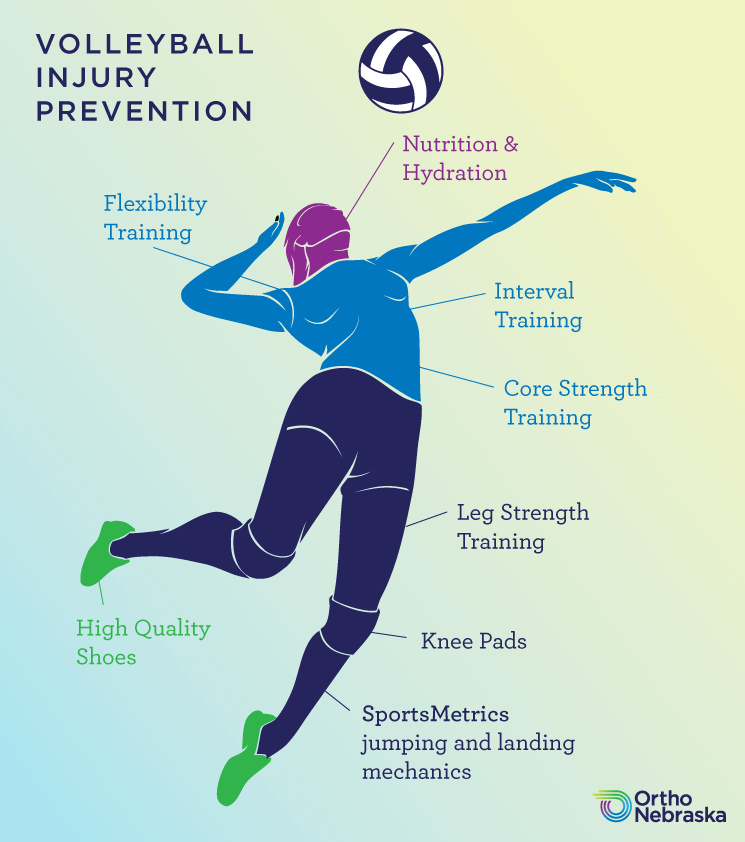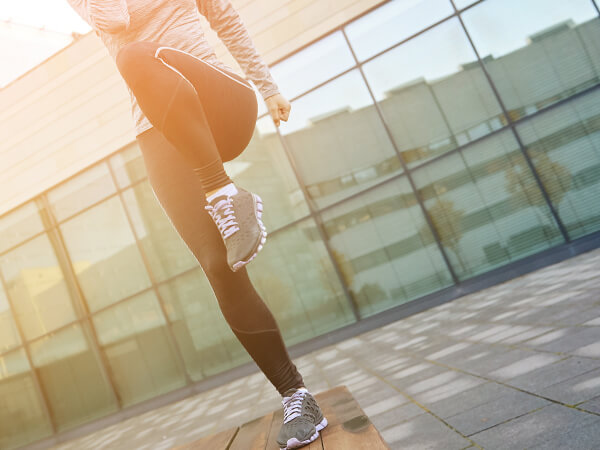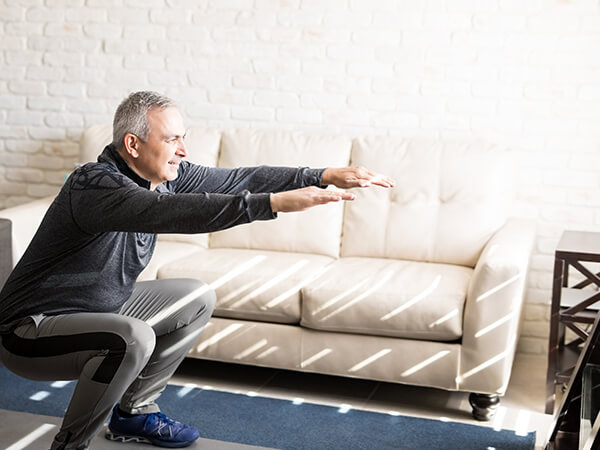07/16/2020
Especially in Nebraska, volleyball has become increasingly popular and competitive. Players often have aspirations of continuing to play in college, so staying healthy despite the rigors of their middle and high school seasons, plus potentially other leagues like the YMCA or Nebraska Elite Volleyball, is important.
Continuous play can lead to overuse injuries, most commonly in the ankle, hand, wrist, elbow, knee or shoulder for volleyball players. Taking part in proper volleyball training, including a program that addresses strength, conditioning and flexibility, will help young volleyball players stay on the court.
What are common volleyball injuries?
- Shoulder injuries such as rotator cuff irritation, tendonitis or tears, or shoulder impingement syndrome are usually cumulative rather than sudden. Overuse is often, but not always, a factor.
- Elbow injuries such as growth plate injuries, bursitis or tennis elbow happen most often for outside hitters due to repeated excessive pressure that spiking can put on the joint.
- Knee injuries such as jumper’s knee (patellar tendonitis), knee ligament (ACL, LCL, MCL or PCL) tears or meniscus tears are common because of all the jumping and landing in volleyball. ACL injuries are associated with a ‘pop’ and immediate swelling.
- Ankle injuries are the culprit for the most lost playing time, and often occur from some combination of fatigue, overuse, poor landing mechanics and colliding with others.
- Hand and wrist injuries such as broken fingers or wrist sprains often happen during blocking, setting or digging.
OrthoNebraska’s Sports Medicine doctors and physical therapists recommend prompt evaluation of pain, especially in high level athletes, to help prevent more serious injuries that may have long-term effects.
What typically causes volleyball injuries?
As with most sports injuries, most volleyball injuries are overuse injuries impacted by overtraining or overplaying. Young athletes whose bodies are rapidly developing and growing need proper rest between practices and games. Proper rest is commonly defined as 1-2 days a week and 2 months a year away from a particular sport or activity.
Muscle imbalances can also be a factor, which most often occur when an athlete is hyper-focused on one sport rather than being a multi-sport athlete. The muscles that are used all the time in the focused sport become stronger and the weaker muscles are then susceptible to injury on the rare occasion they are stressed.
Muscle imbalances result from repetitive motions such as:
- Cutting
- Jumping
- Landing
- Internal rotation of the shoulder during serves and spikes
Improper landing technique, poor core strength or lack of body control can also put undue stress on muscles, ligaments and bones, especially in the knees and ankles. Proper form is landing with knees over toes and hips back.
What can I do to prevent volleyball injuries?
- OrthoNebraska offers an injury prevention program focused on proper form and mechanics called SportsMetrics that is perfectly suited for volleyball players.
- Interval training is helpful for conditioning as opposed to long-distance running, to help the body adjust to the typical rhythm of high-level volleyball. Examples include:
-
- Plyometrics (jumping exercises, see above video)
- Ladder drills
- Shuffling
- Shuttle drills
- Core Strength Training
- Bridges
- Planks
- Medicine ball squats
- Leg Strength Training
- Lunges
- Squats
- Tuck jumps
- Flexibility Training
- Shoulder: external rotation, joint stability and lateral flexibility
- Knee: high knees and hugs, sumo squats, baby skips
- Legs: quad stretch, straight leg run, volleyball shuffle
- Minimize time on hard surfaces, especially during jump training
- Eat lots of proteins, vegetables, calcium, magnesium and vitamin D.
What equipment helps prevent volleyball injuries?
- Knee pads protect from injury when you go hard for a dig or dive on a hard court.
- Ankle braces or taping help prevent you from rolling an ankle
- Wear high-quality volleyball shoes that provide shock absorption and strong ankle and arch support. Here is a list of top shoes in 2020, or you can do your own research or ask a shoe specialist at an athletic shoe store.
- Defensive pants, which are padded from hip to knee, help protect from bumps, bruises and floor burns.
How do I properly warm up for volleyball?
- Be ready and in good physical condition at the start of each league or season. During the offseason, develop a program with the aforementioned elements of interval training, flexibility, core strength training and leg strength training. Make sure you are following the program and ramping up to the start of volleyball activity.
- Warm up and stretch. Research shows that cold muscles are more prone to injury, so warm with jumping jacks or running in place for 3 to 5 minutes. Then slowly and gently stretch the arms, holding each stretch for 30 seconds. Coaches should be encouraging this.
- Cool down and stretch is often forgotten due to busy courts and schedules, but should also be done after practices.
- Hydrate with water or non-sugary and non-caffeinated sports drinks, as research shows that with even mild dehydration, your body will not be able to effectively cool itself through sweat and evaporation. While exact amounts are dependent on the individual’s size, activity level and other health factors, a general recommendation is to drink 24 ounces from 1-2 hours before each practice or game. Drinking an additional 8 ounces of water immediately beforehand and every 20 minutes is another general guideline.
If I suspect an injury or need diagnosed, where should I seek care?
For most acute or sudden injuries, our orthopedic urgent care is a great first step. Open on nights and weekends, you can walk in and see an orthopedic expert, get X-rays done on-site or MRIs ordered if necessary. We’ll then connect you with one of our specialized surgeons as soon as we can.
If your injury has been getting worse over time it may be a better idea to identify a sports medicine doctor you would like to see or call (402) 609-3000 and ask for the first available opening for an appointment that fits your schedule.
Our emergency room is a better option if you have an open wound or open fracture (where a bone is sticking out of the skin), or if our urgent care is closed when your injury occurs and it is too painful to wait.
The main goal of volleyball injury prevention is to minimize injury and sustain athletic careers as long as possible for the players.






